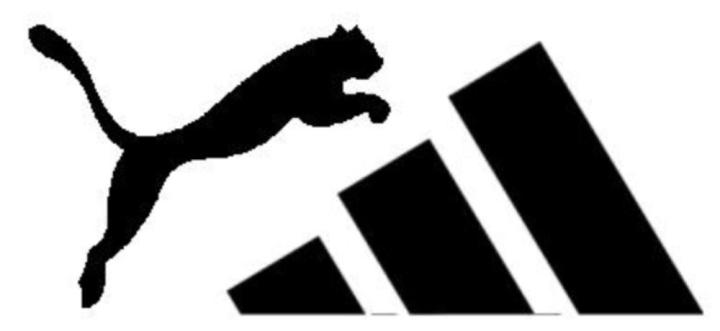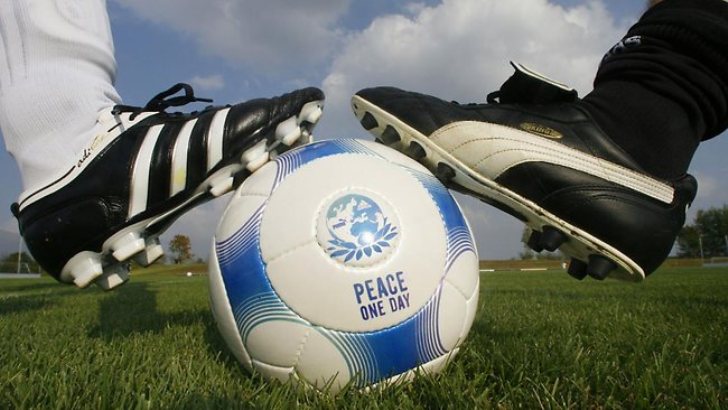 Helmut Fischer will not be cheering for Germany during the European Championship finals. He comes from the Bavarian town of Herzogenaurach where sport is a family affair that gets bitter and personal.
Helmut Fischer will not be cheering for Germany during the European Championship finals. He comes from the Bavarian town of Herzogenaurach where sport is a family affair that gets bitter and personal.
Fischer, 67, said he has always hated the jerseys worn by Die Mannschaft, which are made by Adidas.
“I never watch any of their matches, unless they’re facing a team wearing Puma shirts.”
The pretty town of 25,000 in the southern state of Bavaria is where the Dassler brothers, Adolf and Rudolf, set up their rival sportswear empires, Adidas and Puma.
Fischer has worked for Puma for 38 years and the allegiance goes more than just skin deep. He is proud of his employer’s logo tattooed onto his calves and on his back. And when he meets someone for the first time, he says he “automatically” looks at what they’re wearing on their feet before saying hello.
The habit is so widespread in Herzogenaurach that it has been nicknamed “the town of bent necks.”
For decades, everyone sported their trainers as a sort of flag: Adidas on the southern bank of the Aurach river that divides the town, and Puma to the north.
It has never been quite clear what caused Adolf and his older brother Rudolf to fall out in 1948.
But there has never been a lack of theories — jealousies during the Nazi period, interference by the brothers’ wives, extra-marital affairs.
“The secret has never been uncovered. All of the explanations up until now are just suppositions,” said Joerg Dassler, a grandson of Rudolf, who quit the sports industry to become an event manager.
“No one understood why they fell out,” said Georg Hetzler, an 85-year-old pensioner who was an apprentice tailor when the two brothers broke up their joint company, Dassler Brothers.
Initially hired by Rudolf, he was one of 13 adventurers who followed him to Puma.
– ‘Adi’ Dassler –
Adolf held on to the equipment and most of the workforce and christened his firm Adidas, which combines the abbreviated form of his first name with the first part of his surname.
What ensued was a bitter family feud littered with betrayals and low blows.
During the 1968 Mexico Olympic Games, Adidas had Puma’s shoes held up at customs.
In 1970, Puma broke a gentlemen’s agreement between the two to not hire Pele, taking him on for the World Cup.
“The family feud spread to the entire workforce,” said Joerg Dassler, who only met his grand-uncle Adolf once, in the stands during an athletics championship. The two never spoke.
During the 1960s and 1970s, the “Pumeraner” and the “Adidassler”, as the respective workforces called themselves, “didn’t even sit next to each other in bars,” recalled Georg Hetzler.
“When I started at Adidas 30 years ago, we were forbidden from even mentioning the name Puma. We always had to speak of ‘the competitor on the other side of the Aurach,” Adidas chief executive Herber Hainer told AFP.
“There were restaurants and bars only frequented by Puma employees and others only by Adidas employees. But that’s over now,” he insisted.
On Herzogenaurach’s market place, the 100-year-old bakery, Roemmelt, is staying neutral.
“My parents always had a pair of shoes of each brand in their car, which they would put on,” depending on which firm they were delivering to, smiled Klaus Roemmelt, 53.
A Dassler has not been in charge of either group since the early 1990s.
Adidas and Puma are both now listed on the stock exchange and attract employees from all over the world who are less inclined to carry on the feud.
In face of the battle with the world’s number one sport shoe maker, Nike, the family squabbles are unimportant anyway. Nike, with annual sales of $30.6 billion (26.9 billion euros), dwarfs Adidas with 16.9 billion euros ($19 billion) and Puma with just three billion euros ($2.64).
– A false peace? –
Officially, the two brothers buried the hatchet in 2009 at a football match between teams made up of Adidas and Puma workers mixed together.
Bjorn Gulden, the Norwegian head of Puma, who has also worked at Adidas, insisted the rivalry has reached a “healthy” balance.
But tensions remain. Adidas recently delay a Puma building application for an extension of its headquarters at the town authorities.
Moreover, both accuse the other of plagiarism.
Their two new sportshoe models — Adidas’ “Boost” and Puma’s “NRGY” — look remarkably similar with their soles made of expanded thermoplastic polyurethane (eTPU), a shock-absorbing granulated component. Puma began developing the technology with chemical giant BASF. But BASF pulled out of the partnership to work with Adidas instead.
Puma insists it did everything to reach an amicable agreement. “History is repeating itself,” joked Neil Harriman, Puma’s legal director.
Puma says it invented the detachable cleats used on the Adidas boots worn by German players when they won the 1954 World Cup final.
Ever since, Die Mannschaft has worn the Adidas logo.
Herzogenaurach also has two football teams: ASV, which is sponsored by Adidas, and FC which wears Puma.
Since 2014, young players have trained wearing the same jersey.
“That would have been unthinkable 40 years ago,” said town mayor German Hacker.
But “the final hurdle would be a merger of the two clubs. And that’s a very long way off, with the family lines etched too deeply into people’s minds,” he conceded. – Agence France-Presse



































